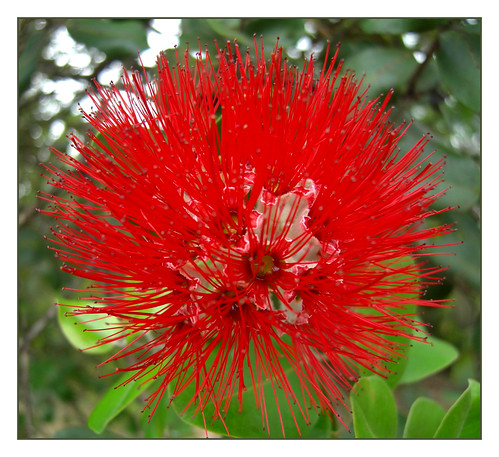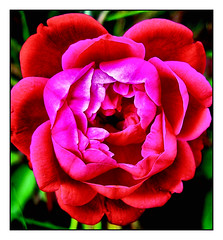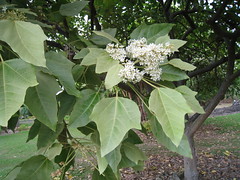Hawaii is home to a vast number of flowers. Some are native Hawaiian flowers and others come from all around the world. Many of the islands have chosen flowers to represent their island, though some islands have chosen other items as their island symbol.
Hawaii’s State Flower: The Yellow Hibiscus
Hawaii’s State Flower is the Yellow Hibiscus (Hibiscus brackenridgei). It is also known as Ma’o hau hele or the Pua aloalo. It is a rare and endangered plant that can be found growing on all of the Hawaiian Islands except for Kaho’olawe and Ni’ihau. The Hibiscus was adopted as the Territory of Hawaii’s flower in the 1920s and later when Hawaii became the 50th state in 1959 the Hibiscus was again chosen as the state flower. But it was not until 1998 that the Yellow Hibiscus was chosen as the state flower.
Prior to 1998, hibiscus flowers of any color were used to represent the state and in fact you’ll see a red hibiscus, rather than a yellow one, on many Hawaiian postcards of that era. There are hundreds of species of hibiscus, but only five are native to the Hawaiian Islands. Many of the other species can be found throughout the Pacific and in Asia, where they are thought to have originated.
Big Island’s Flower: The Ohia Lehua
The red Ohia Lehua is the official flower of the Big Island. The Ohia produces stunning red, orange, yellow or white blossoms. But only the red blossom is the official flower of the island. The Ohia tree can grow really tall. Some approach a height of 98 feet.
According to Hawaiian legend, Ohia and Lehua were young lovers. The volcano goddess, Pele, developed a crush on Ohia, but when he spurned her, she turned him into an Ohia tree. Lehua was crushed by this turn of events and the other Hawaiian gods had pity on her and turned her into a Lehua flower and placed her onto the branches of the Ohia tree. Legend has it that whenever someone picks a Lehua flower and separates Lehua from her Ohia, the sky is said to fill with their tears and it begins to rain.
Oahu’s Flower: The Yellow Ilima
This flower is a popular flower in lei making. It is the official flower of the island of Oahu. It is native to the Hawaiian Islands and the ancient Hawaiians used it medicinally. In some areas it only grows to a foot in height, while in other areas it can grow to five feet tall. Some scientists think that this variation is caused by environmental factors and others think that these may be slightly different but very closely related species. The Ilima resembles a small hibiscus and it is in fact a member of the hibiscus family.
Kauai’s Non-Flower “Flower”: Mokihana
Kauai’s symbol is the mokihana (Pelea anisata). The mokihana is a green berry that grows on the side of Mount Waialelae. It is often interwoven with maile and it smells a little like anise. As you probably know, maile has an amazing fragrance and when combined with mokihana it smells even better. But did you know that the mokihana is a member of the citrus family.
Maui’s Flower: Pink Lokelani
The flower of Maui is the pink lokelani (Rosa damascena). The pink lokelani is a type of cottage rose that smells as good as it looks. The lokelani was brought here in the 1800s, possibly by whalers from New England, and it is well regarded for both its beauty and its fragrance. The lokelani originated in Asia and it was brought to the western world by the Spanish who probably cherished it as much as we do today. People on Maui really took a shine to this flower and made it their official island flower in 1923.
Molokai’s Flower: White Kukui Blossom
The island of Molokai’s flower is the white kukui blossom (Aleurites moluccana). It is the flower of the kukui tree, which produces a nut that is very important to Hawaiian culture. The kukui tree is sometimes called the candlenut tree because its nuts were used as candles. Erly Hawaiians would skewer the nuts on coconut leaf midribs and then light the nuts to use them as candles. The nuts were also eaten, but only after being cooked. Raw nuts are poisonous. Fishermen would chew the nuts and spit them into the water this would reduce the glare and allow them to see fish better. In 1959 the kukui was recognized as Hawaii’s state tree on account of its utility to people.
Lanai’s Non-flower “Flower”: Kauanoa
The kaunaoa, or yellow and orange air plant is Lanai’s symbol. This plant grounds on the sand of Lanai’s beaches. It’s called an air plant because it derives just about everything it needs from the air as the sand has little nutrients. Lei makers like to take the orange strands that it produces and weave them together to accentuate their leis.
Ni’ihau’s Non-Flower “Flower”: White Pupu Shell
Ni’ihau’s symbol is the white pupu shell. These shells are found on the island’s pristine beaches. Ni’ihau’s beaches are pristine because there are few people living on the island, because only native Hawaiians are allowed to live there. These shells are incredible small and rare and it takes a great number of them to make a lei. Sometimes pupu shell leis can cost several thousand dollars because these shells are so rare and these leis are so hard to make.
Conclusion
So have you figured out the common thread that binds all of these symbols together? In case you haven’t noticed the one common bond in all of the symbols is that they are used in lei-making. Most leis are made out of Hawaiian flowers, but in some cases they are made out of other things like berries, air plant strands or even shells.





